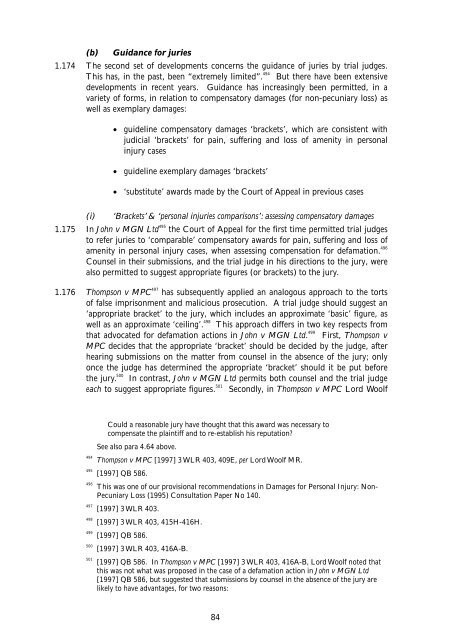Aggravated, Exemplary and Restitutionary ... - Law Commission
Aggravated, Exemplary and Restitutionary ... - Law Commission
Aggravated, Exemplary and Restitutionary ... - Law Commission
Create successful ePaper yourself
Turn your PDF publications into a flip-book with our unique Google optimized e-Paper software.
(b) Guidance for juries<br />
1.174 The second set of developments concerns the guidance of juries by trial judges.<br />
This has, in the past, been “extremely limited”. 494<br />
But there have been extensive<br />
developments in recent years. Guidance has increasingly been permitted, in a<br />
variety of forms, in relation to compensatory damages (for non-pecuniary loss) as<br />
well as exemplary damages:<br />
• guideline compensatory damages ‘brackets’, which are consistent with<br />
judicial ‘brackets’ for pain, suffering <strong>and</strong> loss of amenity in personal<br />
injury cases<br />
• guideline exemplary damages ‘brackets’<br />
• ‘substitute’ awards made by the Court of Appeal in previous cases<br />
(i) ‘Brackets’ & ‘personal injuries comparisons’: assessing compensatory damages<br />
1.175 In John v MGN Ltd 495<br />
the Court of Appeal for the first time permitted trial judges<br />
to refer juries to ‘comparable’ compensatory awards for pain, suffering <strong>and</strong> loss of<br />
amenity in personal injury cases, when assessing compensation for defamation. 496<br />
Counsel in their submissions, <strong>and</strong> the trial judge in his directions to the jury, were<br />
also permitted to suggest appropriate figures (or brackets) to the jury.<br />
1.176 Thompson v MPC 497<br />
has subsequently applied an analogous approach to the torts<br />
of false imprisonment <strong>and</strong> malicious prosecution. A trial judge should suggest an<br />
‘appropriate bracket’ to the jury, which includes an approximate ‘basic’ figure, as<br />
well as an approximate ‘ceiling’. 498<br />
This approach differs in two key respects from<br />
that advocated for defamation actions in John v MGN Ltd. 499<br />
First, Thompson v<br />
MPC decides that the appropriate ‘bracket’ should be decided by the judge, after<br />
hearing submissions on the matter from counsel in the absence of the jury; only<br />
once the judge has determined the appropriate ‘bracket’ should it be put before<br />
the jury. 500<br />
In contrast, John v MGN Ltd permits both counsel <strong>and</strong> the trial judge<br />
each to suggest appropriate figures. 501<br />
Secondly, in Thompson v MPC Lord Woolf<br />
Could a reasonable jury have thought that this award was necessary to<br />
compensate the plaintiff <strong>and</strong> to re-establish his reputation?<br />
See also para 4.64 above.<br />
494 Thompson v MPC [1997] 3 WLR 403, 409E, per Lord Woolf MR.<br />
495 [1997] QB 586.<br />
496 This was one of our provisional recommendations in Damages for Personal Injury: Non-<br />
Pecuniary Loss (1995) Consultation Paper No 140.<br />
497 [1997] 3 WLR 403.<br />
498 [1997] 3 WLR 403, 415H-416H.<br />
499 [1997] QB 586.<br />
500 [1997] 3 WLR 403, 416A-B.<br />
501 [1997] QB 586. In Thompson v MPC [1997] 3 WLR 403, 416A-B, Lord Woolf noted that<br />
this was not what was proposed in the case of a defamation action in John v MGN Ltd<br />
[1997] QB 586, but suggested that submissions by counsel in the absence of the jury are<br />
likely to have advantages, for two reasons:<br />
84
















